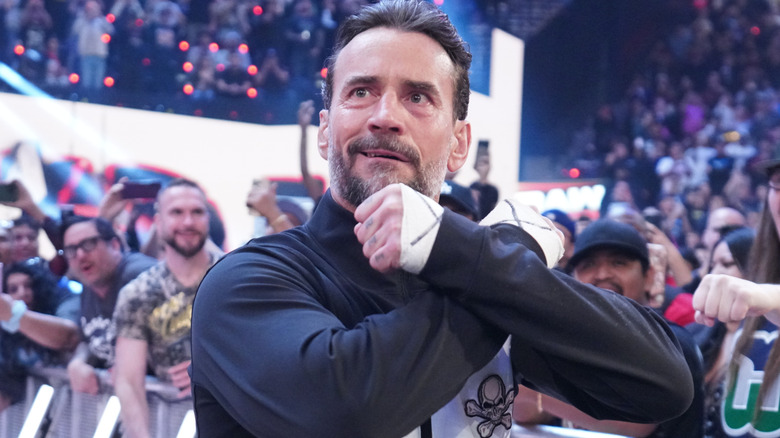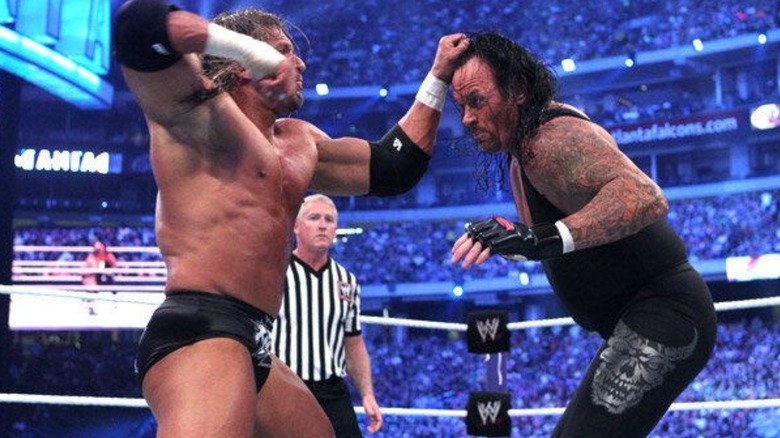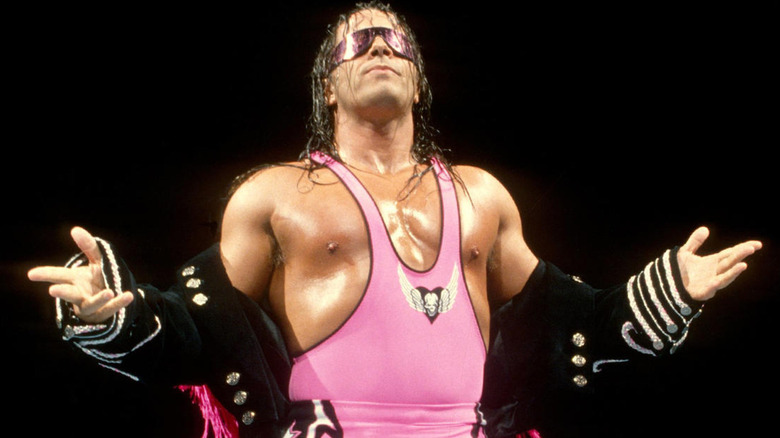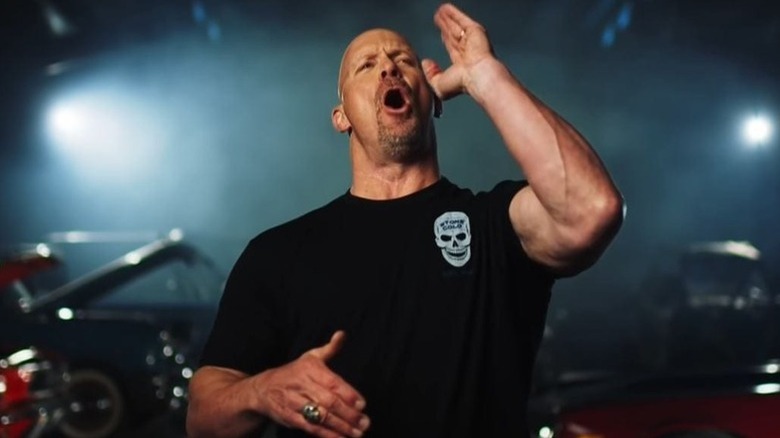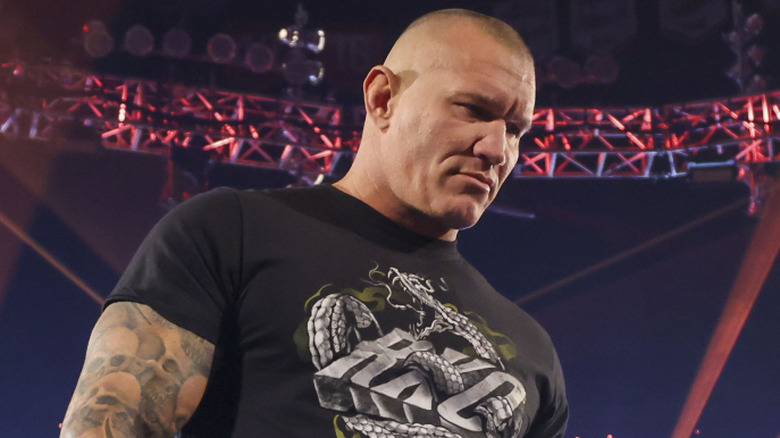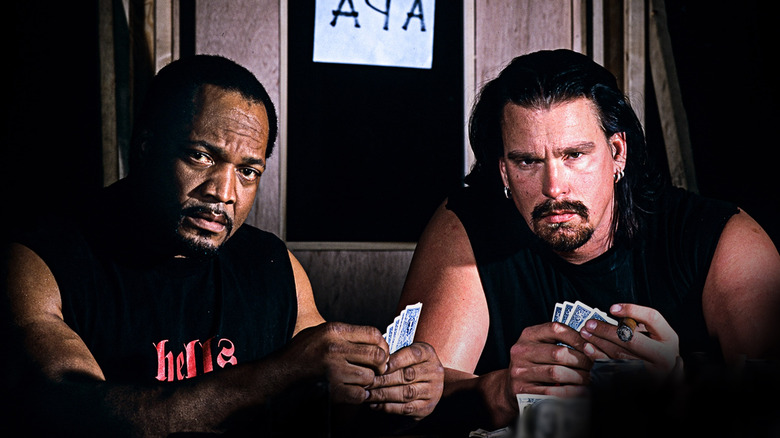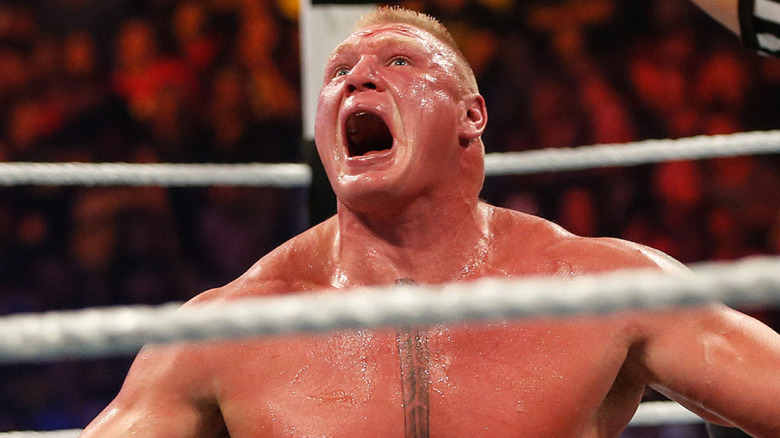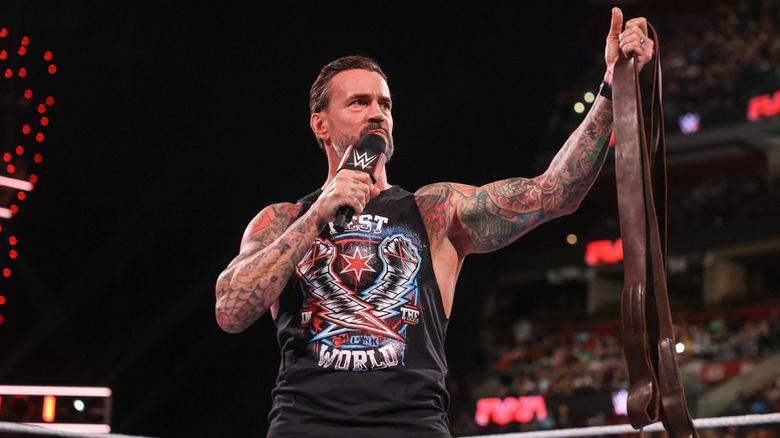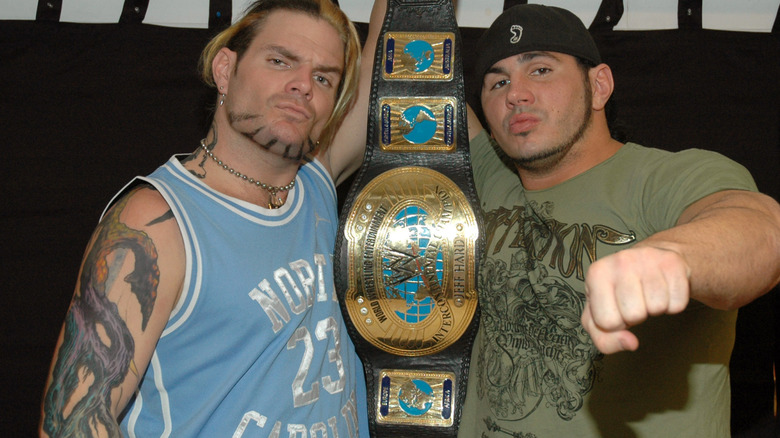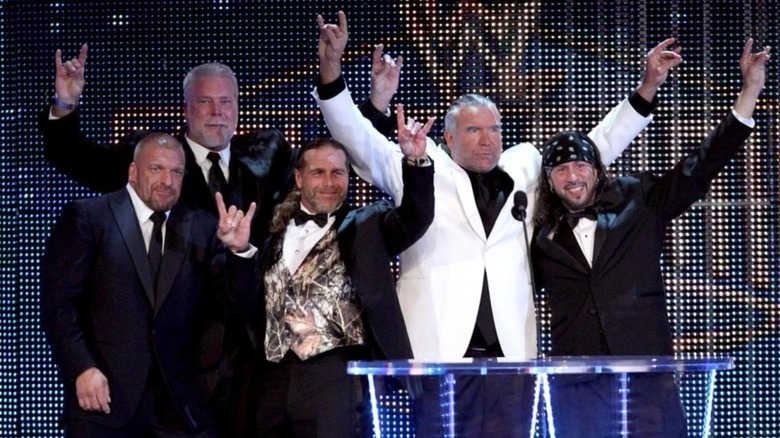Weird Rules Wrestlers Got Away With Breaking
In and out of the ring, wrestlers have to follow a lot of rules. During their matches, referees are there to enforce rules like rope breaks, no outside interference, and getting back into the ring by the count of 10 (or if you're in Japan, the count of 20). However, even the referees have to follow the rules and regulations of the business backstage.
The backstage culture of wrestling is a strange beast. It has vastly improved from the days when performers turned themselves into human pincushions to give themselves bigger muscles, but there are still some written and unwritten rules that everyone needs to follow. With that said, people sometimes get away with breaking these rules for various reasons. Whether it's star power, a receipt from some other incident that took place, or the person running the show shrugging their shoulders, a number of famous faces have gotten away with breaking some of wrestling's most famous laws.
That said, these rules wrestlers must follow aren't as simple as one may originally suspect. Vince McMahon was famous for creating obscure rules that were questionable, but because he was the boss, everyone went along with them. Things like not being allowed to say the word belt, not liking wrestlers to have grey hair, and not being allowed to sneeze as it shows a lack of self-control are just some of the weird rules he enforced. However, there are some weird and not-so-weird rules that performers got away with for different reasons. Keeping that in mind, let's take a look at them.
Triple H and The Undertaker - Chair Shots to the Head
The fact that not hitting your colleague in the head with a chair is a rule is weird in itself. However, by the start of the 2010s, unprotected chair shots to the head had been outlawed in WWE due to the death of Chris Benoit, the discovery of CTE, and an improved concussion protocol. That was until WWE WrestleMania 27 in 2011.
WrestleMania 27 is not remembered fondly, with the only bout that has ever been mentioned in a positive light being the No Holds Barred match between Triple H and The Undertaker. Given that the match had no rules, the participants decided to push the envelope a little bit. During the bout, both men took a swing at each other with a steel chair, with the blows landing directly on each other's heads. The connections were not as rough as years past, but they broke a rule that would have landed most people in such hot water that they might have been out of a job.
Instead, The Undertaker and Triple H were both hit with fines. The Undertaker even thought he would get away with it given both men's status within WWE, and saw it as Vince McMahon setting an example to the roster. However, had it been anyone else, they wouldn't have been so lucky.
Bret Hart - Blading
Blading has been prohibited at many points in WWE history, and the fact so many wrestlers can't resist cutting their own faces with razors is questionable. The no-blood rule was in full effect during the first golden era of WWE in the 1980s and early 1990s, but the WrestleMania VIII match between Bret Hart and Roddy Piper is one that is best remembered for having a splash of crimson.
During his WWE Intercontinental Championship match with Piper, "The Hitman" ran the blade and started bleeding. It wasn't a situation like Eddie Guerrero when he faced JBL in 2004 — who literally needed a transfusion because he bled so much — but it was enough that it made the match instantly stand out in a sea of bloodless matches. Hart was able to overcome his blood loss and win the match, but since he broke the rules, the two men needed a strategy to avoid getting into trouble.
When they got to the back, Hart and Piper staged an argument about an accidental stiff kick to the face. Management caught wind of this, decided not to question it, and brushed it off as a simple accident, despite the fact that Hart went to the ring with a razor blade in his mouth. To make things even better for Hart and Piper, Ric Flair and Randy Savage were fined for bleeding during their match on the night.
Stone Cold Steve Austin - No Alcohol
It's a rule that applies for practically every job imaginable, including WWE. Wrestlers are reportedly not allowed to drink alcohol less than 12 hours before a show for obvious reasons. It's unprofessional, dangerous, and reflects badly on the entire company, with wrestlers being sent home many times for being drunk on the job. Having said all that, it's extremely ironic that one of the most iconic wrestlers of his era was known for drinking copious amounts of beer. So, how did "Stone Cold" Steve Austin get away with drinking so many cold ones in front of millions of people each week?
The simple answer is that he was one of the biggest draws in the history of the business, and his gimmick was that he was a beer-swilling redneck who loved kicking a** wherever he went, but there is more to it. Many have speculated that due to how he throws the cans around, Austin doesn't even drink much of the beer anyway. Others see him drinking light beer as a reason, and if he was consuming something like Guinness, it would be a lot different.
However, for one specific match, Austin himself gave an actual reason for his drinking: a dry mouth, Austin drank his own brand beer, Broken Skull Lager, during his WrestleMania 38 match with Kevin Owens. He explained that whenever he felt himself getting cottonmouth, he'd grab a beer and carry on. The "Texas Rattlesnake" also passed it off as the beer flying everywhere adding to the spectacle of what was less of a match and more of a brawl, and while he won't admit it, the free promotion didn't hurt either.
Randy Orton - Various Suspensions
Similar to the alcohol rule, drugs are prohibited in all lines of work, and wrestling is almost no different. The reason we say almost is because wrestlers are prescribed medication when they are in extreme pain, or if they are rehabbing an injury. However, smoking marijuana often gets people fired, or at the very least, suspended. RVD had his push to the top of WWE derailed just for being in possession of it, so surely someone would be in the unemployment line for being high, right?
Not exactly, as Randy Orton was suspended for 60 days after smoking marijuana backstage in March 2006. Once the summer was over, he was suspended again for violating the wellness policy, serving a 30-day suspension. He was suspended for a third time a year later for being involved in the Signature Pharmacy scandal. After that, Orton received a fourth suspension in 2012 for violating the wellness policy again, which would lead to most other stars being fired as the company has a three-strikes-and-out rule.
Orton's marijuana bust and the Signature Pharmacy incident were treated separately, hence why he kept his job after getting into so much trouble. Also, if you're worried about him getting fired for violating the wellness policy for a third time, never fear as Orton had one of his strikes removed in 2013, as WWE removes them if a violator stays on the straight and narrow for 18 months after their suspension.
If you or anyone you know needs help with addiction issues, help is available. Visit the Substance Abuse and Mental Health Services Administration website or contact SAMHSA's National Helpline at 1-800-662-HELP (4357).
The Acolytes - Intentionally Hurting Opponents
This rule is fairly self-explanatory, but it is one that wrestlers routinely break for various reasons. When fans go and watch a wrestling show, they know that the people in the ring are trained professionals who aren't actively trying to hurt each other. There have been numerous examples on independent shows and in other promotions where people have gone out of their way to "stiff" opponents for various reasons, but in WWE, there was one very famous example involving Bradshaw and Faarooq, aka The Acolytes.
During an episode of "WWE Sunday Night Heat" in March 1999, The Acolytes were set to have a match with former ECW and WCW stars The Public Enemy, who were supposed to go through a set of tables at the end of the match, ultimately setting up the first-ever tag team tables match at a pay-per-view. However, Rocco Rock and Johnny Grunge both said that they didn't want to do the finishing spot. In response, The Acolytes took the fight to The Public Enemy.
What followed was one of the most brutal beatings ever captured by WWE cameras, with Bradshaw later admitting that he thought both he and Faarooq would be fired for going into business for themselves. Instead, The Public Enemy were fired a few weeks later, after word spread that they refused to do the planned finish, and the beating they sustained at the hands of Bradshaw and Faarooq would not only go unpunished, but was celebrated among the other wrestlers in the WWE locker room.
Brock Lesnar -Third Party Advertisements
When Brock Lesnar returned to WWE in 2012, one of the biggest priorities for Vince McMahon when it came to negotiating with the former UFC Heavyweight Champion was simple: keep "The Beast Incarnate" happy by any means necessary. This goal ultimately led to Lesnar being allowed to break one of the strangest rules that is still enforced to this day in WWE regarding third party outlets.
The third party situation really came to light during the COVID-19 pandemic, as various WWE Superstars looked to make a little extra money on the side. However, WWE put a stop to all of this by prohibiting its performers from monetizing their social media accounts, stopping them from streaming on third party platforms such as Twitch, and profiting from any outside advertisements unless the company got a cut of the revenue. However, Lesnar was allowed to break the last rule without dealing with the consequences.
At Extreme Rules 2012, when Lesnar faced John Cena, "The Beast" had a number of outside sponsors on his ring gear. There was Deathclutch, the name of Lesnar's gym and associated fashion brand. Dymatize Nutrition, with whom Lesnar had also partnered with, and Jimmy John's Sandwiches, an agreement that started during Lesnar's time with the UFC. WWE might have a number of sponsorships showcased these days, but Lesnar was the only one to get away with the third party rule.
CM Punk - No Touching Fans
This rule is a little more complicated than the rest. The "no touching fans" rule was actually introduced in 2020 due to the COVID-19 pandemic, and it was only enforced during meet-and-greet autograph signings. Obviously, wrestlers high-five fans all the time, brawl through the crowd during matches, and in the case of people like Jey Uso, The Shield, or even The Sandman, they enter through the crowd. CM Punk wasn't even with WWE in 2020, but he got away with touching a fan in a very serious way during his time as WWE Champion.
Fans can get a bit touchy-feely when wrestlers end up in the crowd, hence why there are so many security guards scattered around the arena. However, during an episode of "WWE Raw" in 2012, one fan touched Punk so much that the then-WWE Champion turned around and punched the spectator repeatedly before exiting the arena. Now, this all sounds extremely serious to the point where if it happened on the street, Punk would be arrested, but what if we told you that he didn't even hit the right person? That's right, Punk turned around and hit the wrong guy.
So how did Punk get away with it? Well, after issuing a very sincere apology, the actual person who hit him started bragging on social media and essentially took full credit for making the fan who Punk attacked a millionaire through damages. In the end, the fan Punk assaulted thought about hiring a lawyer to represent him in a case against the star and WWE, but decided not to press charges due to insufficient evidence. Punk was allowed to reign as WWE Champion until January 2013, and it's still unknown if the fan got any compensation.
The Hardy Boyz - Respecting the Veterans
Wrestling has always had a respect your elders type of mentality. It doesn't matter how successful you might be at an early age, but you have to always give credit to those who came before. This rule was broken by The Hardy Boyz in 1999, but only because they were encouraged to.
After winning their first set of WWE Tag Team Championships from The Acolytes, Matt and Jeff Hardy were going to ride the high life in first class on their flight back home alongside their then-manager Michael Hayes. However, Glen "Kane" Jacobs was late getting on the flight and was unable to sit in first class like he was supposed to. Matt and Jeff, being respectful, offered up their seats, but Hayes wanted to reward them for winning their first WWE titles. Naturally, the veterans on the plane took offence to this, leading to The Hardy Boyz and Michael Hayes ending up in Wrestler's Court.
Wrestler's Court was a kangaroo court designed by the veterans to keep the locker room in line, and it resulted in some serious hazing back in the day. Matt and Jeff could have faced serious punishment, but due to Hayes being the one to put them up to staying in first class, JBL told The Hardy Boyz to play along with his theatrical retelling of the tag champs telling Kane he's "an old piece of s**t" and buy The Undertaker some Jack Daniels and they were off the hook. As for Hayes, he lost his first class privileges and had to buy Kane his lunch for a whole month.
The Kliq - Breaking Kayfabe
Arguably the weirdest rule in all of wrestling, especially in the modern era, is to never let the audience know that what they are watching is not a real fight and more of a performance. In 2025, kayfabe is virtually dead as everyone knows wrestling is pre-determined, and in 1996 it was pretty much dead as well, or at least on its deathbed. But if it wasn't dead by 1996, The Kliq put the nail in the coffin.
The "Curtain Call" is one of the most infamous moments in WWE history. The night where Shawn Michaels, Razor Ramon, Diesel, and Hunter Hearst Helmsley revealed to a packed Madison Square Garden crowd that they were actually very good friends in real life. They all hugged in the middle of the ring, raised each other's hands, and shattered the illusion of kayfabe forever, which you would think would lead to hefty punishments, but not with The Kliq.
Given that Kevin "Diesel" Nash and Scott "Razor Ramon" Hall were leaving WWE after the Madison Square Garden show, there was no way they could be punished. Shawn Michaels wasn't punished either, as he was the WWE Champion, and was genuinely untouchable at a time where the company had entered into a war with WCW on Monday nights.
On top of this, Sean Waltman wasn't punished because he wasn't in the ring, which just left Paul Levesque. While he had his scheduled 1996 King of the Ring victory taken away from him, he went on to become one of the company's biggest stars and executives, showing that the punishment was only a slight blemish on his record.
